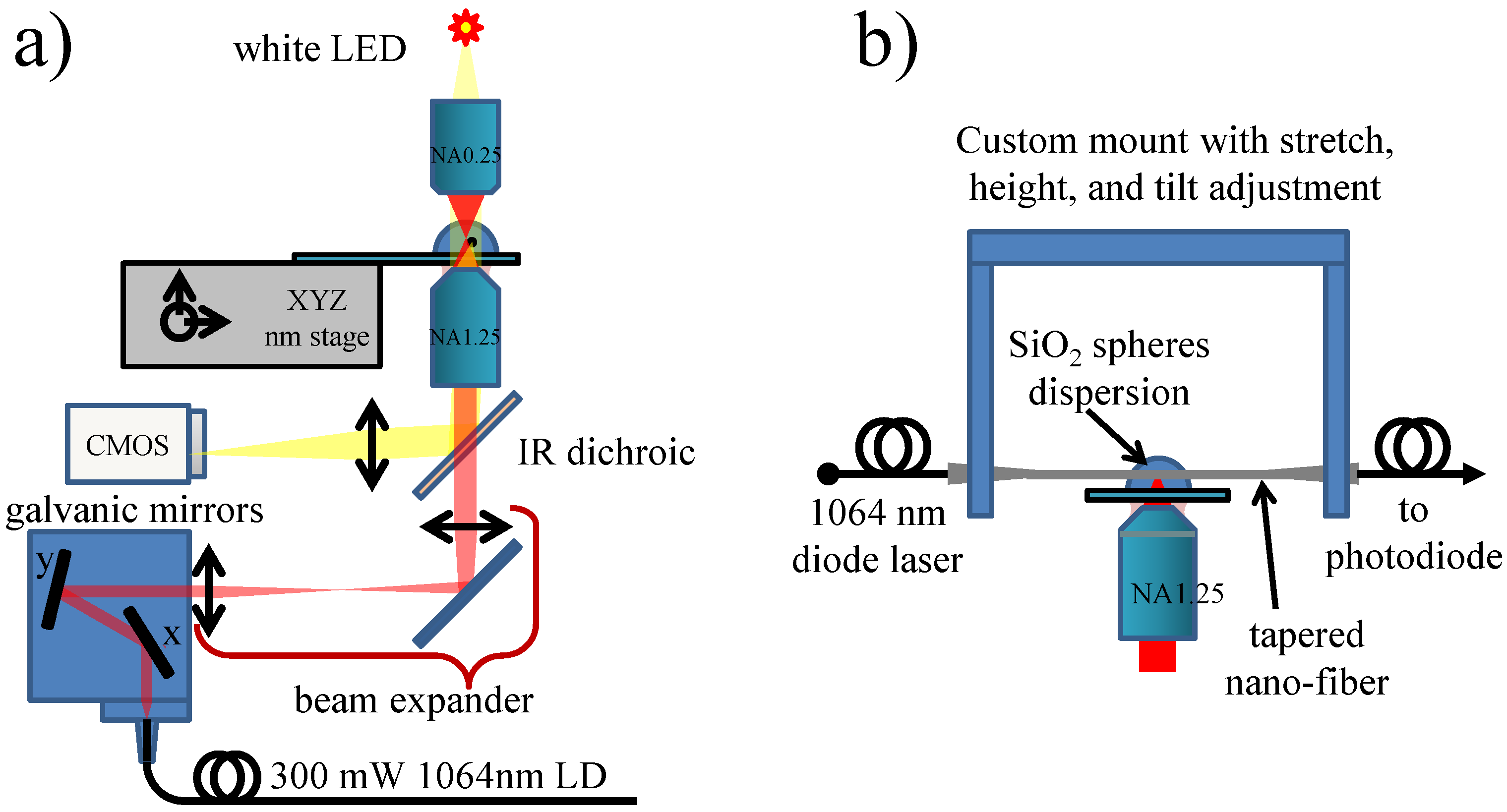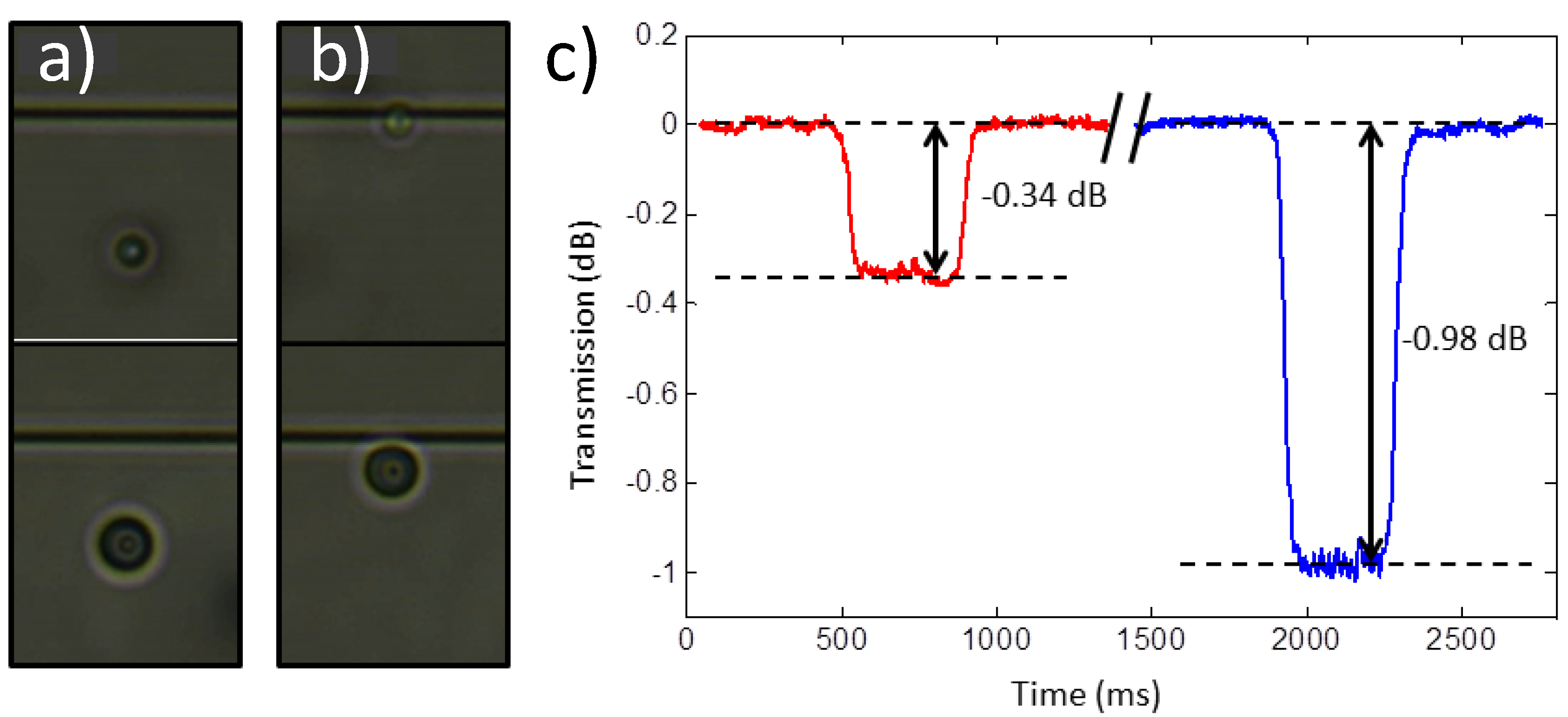Optical Nanofiber Integrated into Optical Tweezers for In Situ Fiber Probing and Optical Binding Studies †
Abstract
:1. Introduction
2. Experimental Methods
2.1. Optical Tweezers
2.2. Optical Nanofiber Fabrication, Mounting and Integration

2.3. Nanofiber in Dispersion
2.4. Data Acquisition and Treatment

3. Results and Discussion
3.1. Trapped Particle as a Probe of Fiber Diameter and Field Distribution

3.2. Fiber Transmission as a Function of Fiber-Particle Separation

3.3. Transmission Modulation Induced by Two Particles

4. Conclusions
Acknowledgments
Author Contributions
Conflicts of Interest
References
- Ashkin, A. Acceleration and trapping of particlesby radiation pressure. Phys. Rev. Lett. 1970, 24, 24–27. [Google Scholar] [CrossRef]
- Ashkin, A.; Dziedzic, J.M. Optical trapping and manipulation of viruses and bacteria. Science 1987, 235, 1517–1520. [Google Scholar] [CrossRef] [PubMed]
- Kuo, S.C.; Sheetz, M.P. Force of single kinesin molecules measured with optical tweezers. Science 1993, 260, 232–234. [Google Scholar] [CrossRef] [PubMed]
- Curtis, J.E.; Koss, B.A.; Grier, D.G. Dynamic holographic optical tweezers. Opt. Commun. 2002, 207, 169–175. [Google Scholar] [CrossRef]
- Simpson, N.B.; Dholakia, K.; Allen, L.; Padgett, M.J. Mechanical equivalence of spin and orbital angular momentum of light: An optical spanner. Opt. Lett. 1997, 22, 52–54. [Google Scholar] [CrossRef] [PubMed]
- Liu, Z.; Guo, C.; Yang, J.; Yuan, L. Tapered fiber optical tweezers for microscopic particle trapping: Fabrication and application. Opt. Express 2006, 14, 12510–12516. [Google Scholar] [CrossRef] [PubMed]
- Dholakia, K.; Zemánek, P. Colloquium: Gripped by light: Optical binding. Rev. Mod. Phys. 2010, 82, 1767–1791. [Google Scholar] [CrossRef]
- Enger, J.; Goksör, M.; Ramser, K.; Hagberg, P.; Hanstorp, D. Optical tweezers applied to a microfluidic system. Lab Chip 2004, 4, 196–200. [Google Scholar] [CrossRef] [PubMed]
- Kawata, S.; Sugiura, T. Movement of micrometer-sized particles in the evanescent field of a laser beam. Opt. Lett. 1992, 17, 772–774. [Google Scholar] [CrossRef] [PubMed]
- Gu, M.; Haumonte, J.B.; Micheau, Y.; Chon, J.W.M.; Gan, X. Laser trapping and manipulation under focused evanescent wave illumination. Appl. Phys. Lett. 2004, 84, 4236–4238. [Google Scholar] [CrossRef]
- Yang, A.H.J.; Moore, S.D.; Schmidt, B.S.; Klug, M.; Lipson, M.; Erickson, D. Optical manipulation of nanoparticles and biomolecules in sub-wavelength slot waveguides. Nature 2009, 457, 71–75. [Google Scholar] [CrossRef] [PubMed]
- Šiler, M.; Čižmár, T.; Šerý, M.; Zemánek, P. Optical forces generated by evanescent standing waves and their usage for sub-micron particle delivery. Appl. Phys. B 2006, 84, 157–165. [Google Scholar] [CrossRef]
- Šiler, M.; Čižmár, T.; Jonáš, A.; Zemánek, P. Surface delivery of a single nanoparticle under moving evanescent standing-wave illumination. New J. Phys. 2008, 10, 113010. [Google Scholar] [CrossRef]
- Tong, L.; Lou, J.; Mazur, E. Single-mode guiding properties of subwavelength-diameter silica and silicon wire waveguides. Opt. Express 2004, 12, 1025–1035. [Google Scholar] [CrossRef] [PubMed]
- Tong, L.; Sumetsky, M. Subwavelength and Nanometer Diameter Optical Fibers; Zejiang University Press: Hangzhou, China; Springer-Verlag: Berlin, Germany, 2010. [Google Scholar]
- Wu, X.; Tong, L. Optical microfibers and nanofibers. Nanophotonics 2013, 2, 407–428. [Google Scholar] [CrossRef]
- Kumar, R.; Gokhroo, V.; Deasy, K.; Nic Chormaic, S. Autler-Townes splitting via frequency up-conversion at ultralow-power levels in cold 87Rb atoms using an optical nanofiber. Phys. Rev. A 2015, 91, 2–6. [Google Scholar] [CrossRef]
- Ward, J.M.; Féron, P.; Nic Chormaic, S. A taper-fused microspherical laser source. IEEE Photonics Technol. Lett. 2008, 20, 392–394. [Google Scholar] [CrossRef]
- Morrissey, M.J.; Deasy, K.; Frawley, M.; Kumar, R.; Prel, E.; Russell, L.; Truong, V.G.; Nic Chormaic, S. Spectroscopy, manipulation and trapping of neutral atoms, molecules, and other particles using optical nanofibers: A review. Sensors (Basel, Switzerland) 2013, 13, 10449–10481. [Google Scholar] [CrossRef] [PubMed]
- Chen, G.Y.; Ding, M.; Newson, T.P.; Brambilla, G. A review of microfiber and nanofiber based optical sensors. Open Opt. J. 2013, 7, 32–57. [Google Scholar] [CrossRef]
- Brambilla, G.; Murugan, G.S.; Wilkinson, J.S.; Richardson, D.J. Optical manipulation of microspheres along a subwavelength optical wire. Opt. Lett. 2007, 32, 3041–3043. [Google Scholar] [CrossRef] [PubMed]
- Lei, H.; Xu, C.; Zhang, Y.; Li, B. Bidirectional optical transportation and controllable positioning of nanoparticles using an optical nanofiber. Nanoscale 2012, 4, 6707. [Google Scholar] [CrossRef] [PubMed]
- Zhang, Y.; Li, B. Particle sorting using a subwavelength optical fiber. Laser Photonics Rev. 2013, 7, 289–296. [Google Scholar] [CrossRef]
- Lei, H.; Zhang, Y.; Li, X.; Li, B. Photophoretic assembly and migration of dielectric particles and Escherichia coli in liquids using a subwavelength diameter optical fiber. Lab Chip 2011, 11, 2241–2246. [Google Scholar] [CrossRef] [PubMed]
- Xin, H.; Li, Y.; Li, L.; Xu, R.; Li, B. Optofluidic manipulation of Escherichia coli in a microfluidic channel using an abruptly tapered optical fiber. Appl. Phys. Lett. 2013, 103, 6720–6724. [Google Scholar] [CrossRef]
- Frawley, M.C.; Gusachenko, I.; Truong, V.G.; Sergides, M.; Nic Chormaic, S. Selective particle trapping and optical binding in the evanescent field of an optical nanofiber. Opt. Express 2014, 22, 16322. [Google Scholar] [CrossRef] [PubMed]
- Maimaiti, A.; Truong, V.G.; Sergides, M.; Gusachenko, I.; Nic Chormaic, S. Higher order microfiber modes for dielectric particle trapping and propulsion. Sci. Rep. 2015, 5. [Google Scholar] [CrossRef] [PubMed]
- Gittes, F.; Schmidt, C.F. Interference model for back-focal-plane displacement detection in optical tweezers. Opt. Lett. 1998, 23, 7–9. [Google Scholar] [CrossRef] [PubMed]
- Thalhammer, G.; Obmascher, L.; Ritsch-Marte, M. Direct measurement of axial optical forces. Opt. Express 2015, 23, 6112. [Google Scholar] [CrossRef] [PubMed]
- Yalla, R.; Le Kien, F.; Morinaga, M.; Hakuta, K. Efficient channeling of fluorescence photons from single quantum dots into guided modes of optical nanofiber. Phys. Rev. Lett. 2012, 109, 1–5. [Google Scholar] [CrossRef]
- Gregor, M.; Kuhlicke, A.; Benson, O. Soft-landing and optical characterization of a preselected single fluorescent particle on a tapered optical fiber. Opt. Express 2009, 17, 24234–24243. [Google Scholar] [CrossRef] [PubMed]
- Ward, J.M.; Maimaiti, A.; Le, V.H.; Nic Chormaic, S. Contributed Review: Optical micro- and nanofiber pulling rig. Rev. Sci. Instrum. 2014, 85, 111501. [Google Scholar] [CrossRef] [PubMed]
- Birks, T.A.; Li, Y.W. The shape of fiber tapers. J. Lightwave Technol. 1992, 10, 432–438. [Google Scholar] [CrossRef]
- Frawley, M.C.; Petcu-Colan, A.; Truong, V.G.; Nic Chormaic, S. Higher order mode propagation in an optical nanofiber. Opt. Commun. 2012, 285, 4648–4654. [Google Scholar] [CrossRef]
- Gibson, G.M.; Leach, J.; Keen, S.; Wright, A.J.; Padgett, M.J. Measuring the accuracy of particle position and force in optical tweezers using high-speed video microscopy. Opt. Express 2008, 16, 14561–14570. [Google Scholar] [CrossRef] [PubMed]
- Xin, H.; Li, B. Targeted delivery and controllable release of nanoparticles using a defect-decorated optical nanofiber. Opt. Express 2011, 19, 13285–13290. [Google Scholar] [CrossRef] [PubMed]
- Ravets, S.; Hoffman, J.E.; Orozco, L.A.; Rolston, S.L.; Beadie, G.; Fatemi, F.K. A low-loss photonic silica nanofiber for higher-order modes. Opt. Express 2013, 21, 18325. [Google Scholar] [CrossRef] [PubMed]
© 2015 by the authors; licensee MDPI, Basel, Switzerland. This article is an open access article distributed under the terms and conditions of the Creative Commons Attribution license (http://creativecommons.org/licenses/by/4.0/).
Share and Cite
Gusachenko, I.; Truong, V.G.; Frawley, M.C.; Nic Chormaic, S. Optical Nanofiber Integrated into Optical Tweezers for In Situ Fiber Probing and Optical Binding Studies. Photonics 2015, 2, 795-807. https://doi.org/10.3390/photonics2030795
Gusachenko I, Truong VG, Frawley MC, Nic Chormaic S. Optical Nanofiber Integrated into Optical Tweezers for In Situ Fiber Probing and Optical Binding Studies. Photonics. 2015; 2(3):795-807. https://doi.org/10.3390/photonics2030795
Chicago/Turabian StyleGusachenko, Ivan, Viet Giang Truong, Mary C. Frawley, and Síle Nic Chormaic. 2015. "Optical Nanofiber Integrated into Optical Tweezers for In Situ Fiber Probing and Optical Binding Studies" Photonics 2, no. 3: 795-807. https://doi.org/10.3390/photonics2030795



